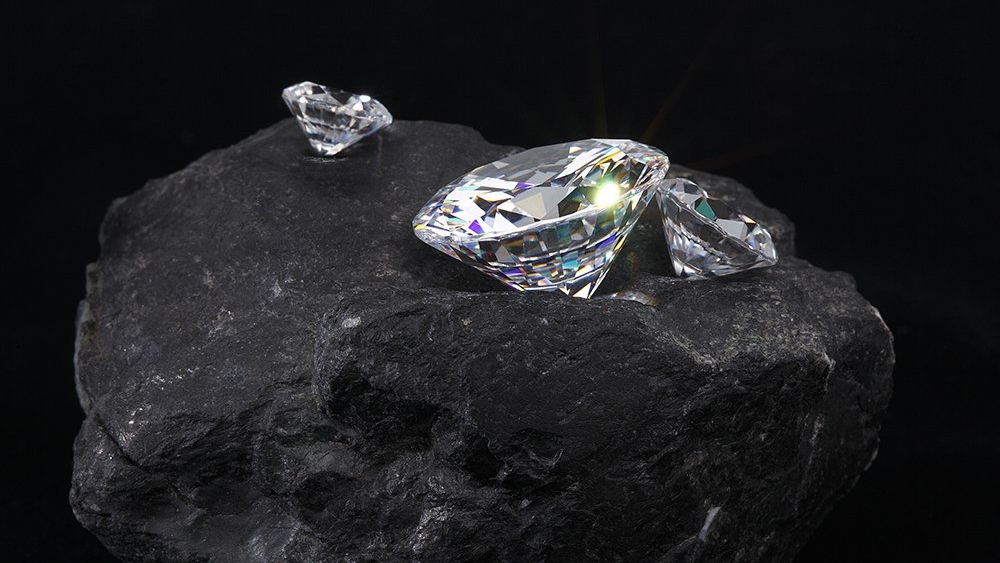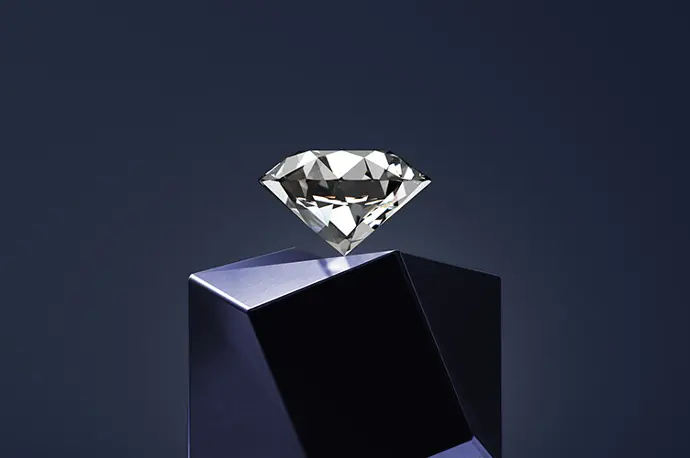How Are Natural Diamonds Formed?
Natural diamonds are famously the only gemstone made of a single element, carbon. They’re formed under high temperature and pressure conditions for billions of years hundreds of miles beneath the earth’s surface.
In areas of the globe where the conditions and temperatures have been ripe to produce diamonds volcanic eruptions deep in the earth eject the stones towards the earth’s surface via kimberlite pipes, to then be unearthed by miners.
Natural Diamond

The crystal structure of a diamond is isometric, which means that the carbon atoms are bonded in the same way in all directions making the diamond not just one of the hardest natural substances, but also so visually extraordinary.
How are Lab Grown Diamonds Created?
As their name suggests, lab grown diamonds are just that–diamonds that have been created in a laboratory using advanced technology, such as Chemical Vapour Deposition (CVD) or High Pressure High Temperature (HPHT) methods, which mimic the natural process of diamond formation.
The most common way is CVD, where you begin with a ‘slice’ of a diamond where the crystalline structure has already formed.
This is usually called the diamond ‘seed’ and it’s then placed in a vacuum where the carbon molecules assimilate to the diamond seed to grow, just like a natural diamond. If you want to get even more technical, you can learn more about the lab grown diamond growing techniques here.
General Electric created the first batch of lab grown diamonds back in the 1950s under a programmed called Project Super pressure, but they’ve only very recently become commercially available as they’ve become more affordable and their quality has improved in the last ten years.
There are no gemological differences. Both natural and lab grown diamonds are pure carbon, so technically and chemically speaking, they’re the exact same. To the untrained, naked eye, you’d never know the difference.
The quality and durability of these stones are the exact same. Lab grown diamonds are created in controlled conditions and treated to ensure their internal characteristics are the same as natural diamonds.
Can you tell the difference between lab grown diamonds and natural diamonds?
Not with the naked eye, but you can via testing, which is how grading laboratories determine what is a natural or lab grown diamond.
The appearance of the two diamond types is the same given the fact that they share the exact same structure and properties, but physically a lab grown diamond will display differences in the structure of the diamond. That’s how grading laboratories are able to test and tell them apart.
Are Lab Grown Diamonds Real?
Lab Grown Diamond

Lab grown diamonds are real and should not be considered a diamond simulant. Diamond simulants are gemstones engineered to mimic diamonds, without actually being diamonds such as moissanite and cubic zirconia. These stones have an entirely different chemical makeup to diamonds, whereas lab grown diamonds and natural diamonds share the exact same structure and properties.
Diamond simulants actually look very different to diamonds. The biggest telltale sign will always be the way the light reacts with the stone’s facets, better known as “sparkle”.
The facets in a moissanite or cubic zirconia often won’t be as bright, crisp or as lustrous as a diamond–lab grown or natural.
Is it Accurate to Call a Lab Grown Diamond a ‘synthetic’ Diamond?
The Federal Trade Commission revised their jewelry marketing guidelines, which achieved a few important changes to help consumers understand the differences between natural and lab grown diamonds.
They stated that the term synthetic cannot be applied to lab grown diamonds because they are made from pure carbon, just as mined, earth-grown diamonds are.
At the same time they insisted that the words laboratory grown are always used before the word diamond, when promoting lab diamonds to ensure customers know the difference. For natural diamonds, retailers do not need to state natural diamonds. If a retailer sells a natural diamond it is sufficient to just describe it as a “diamond”.
How Are Natural Diamonds Graded?
Due to their iconic and exceptional reputation, we only use Gemological Institute of America graded center natural diamonds.
The is an international non-profit organization dedicated to producing consistent, accurate and unbiased grading reports.
Each stone is graded twice, by different graders, to ensure they arrive at the same grading report.
How are Lab Grown Diamonds Graded?
The Gemological Institute of America has graded the color, clarity and cut standards of lab grown diamonds with additional information as to whether the diamond was created via CVD or HPHT growing technique.
However, instead of using the terms like VS2 to grade clarity or ‘D’ to define color, GIA chooses to identify color and clarity with descriptive terms. Because of this, some people prefer International Gemological Institute-graded lab diamonds.
Known as the IGI, this certification body uses the global standard for grading color and clarity. The third certification body is the Gem Certification & Assurance Lab, known as GCAL.
How Sustainable Are Lab Grown Diamonds?
Both natural and lab grown diamonds impact the environment–let’s explore how each of them do.
The CVD process involved placing the diamond ‘seed’ in a carbon gas chamber where the temperature is between 1500 and 2800 degrees Celsius.
The HPHT process refers to ‘high pressure and high temperature’. The diamond ‘seed’ is placed into a carbon gas chamber at around 3000-4000 degrees Celsius with high levels of carbon gas.
Typically, all lab grown diamonds education go through HPHT treatment.
While lab grown diamonds do increase the transparency of the supply chain, they also require an energy-intensive process to create.


